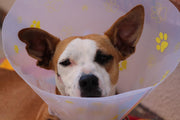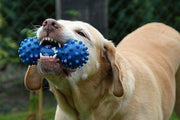
Among the few cringe yet funny behaviors dogs sometimes demonstrate in front of your friends is dog scooting: the action of dragging their butt across the carpet, grass, or floor. You may be wondering why your dog scoots and the common causes of dog scooting.
Unfortunately, your dog may be scooting because of discomfort or pain in his bottom area. The main reason dogs scoot is directly linked to their bottom area. However, some of the other reasons may be hard to identify and diagnose without the help of your veterinarian.
Let's cover the eight main reasons that could explain dog scooting behavior.
Why do dogs scoot on their butts?

Dogs drag their bottom, and it's not necessarily a reason to be alarmed. It may happen after a dog poops or occasionally. Nevertheless, it's not typical for a dog to scoot multiple times a day. Repetitive scooting could indicate a more serious issue that your veterinarian can help you diagnose and treat.
Once again, scooting along the floor is considered normal when occasional. So let's dive into the eight possible causes of your dog dragging his rear end along the floor.
1. Anal sac issues
The primary and most common cause of scooting is when a dog's anal sacs are full or inflamed. The anal sacs are two anal glands located around the dog's anus. If you have ever wondered why dogs smell other dogs' bottoms, this is why. Anal glands release a distinct aroma when pooping, which is part of their territory marking behavior. Therefore, other animals can identify your pup by smelling his poop or his bottom!
Dogs typically express the anal glands when they poop. If the glands are not working correctly, the fluid can build up, and when they become too full, they may become painful. If the glands are inflamed, the liquid inside tends to solidify, making the release more difficult.
When you see your dog dragging his bottom along the floor, he may be trying to relieve the pressure. You may see a discolored trail or a smelly fog following your dog's scooting.
Inspect your dog's bottom and look for bleeding, bruising pus, or swelling. If you spot any unusual symptoms, take your dog to the vet, as some anal gland infections will require a prescribed treatment.
Whether this cause explains your dog scooting or not, we will cover later a few different ways you can help prevent scooting.
2. Allergies

The second common cause of scooting is allergies. If you notice your dog is also scratching, this is a strong indicator that your dog could have food allergies or environmental allergies.
Various things may cause allergies
- Flea bite: allergy to flea saliva.
- Pollen, dust mites, grass allergy: seasonal allergies.
- Food sensitivities: allergy to specific proteins or grains. Beef or chicken are common culprits in kibble diets.
- A weakened immune system, or gut. I wrote an article on 17 ways to improve your dog's gut health.
Allergies usually include the following symptoms:
- Itching, scratching.
- Excessive licking of the paws.
- Chronic ear infections.
- Hot spots, hair loss, skin infections.
If you notice your dog itches a lot, you may try one of our 21 natural home remedies to soothe his itch.
Sometimes, your dog will become allergic to the main protein like chicken or beef in his diet and start scooting. Also, his diet could be missing fiber. Veterinarians often recommend adding the following to a dog's diet:
- Pumpkin. If possible, organic. Pumpkin is excellent for dogs and an excellent source of fiber that supports good digestion. There are also commercial anal gland supplements that contain fiber.
- Fish oil or salmon oil. They are a great source of Omega-3s, which help strengthen the immune system and fight allergies.
3. Parasites

Another common reason your dog drags his bottom is parasites, such as tapeworms. You can spot a tapeworm by its tiny egg-carrying segments that look like rice and appear in your dog's poop.
Tapeworms can cause itching and irritation around the anus. Your veterinarian will be most apt to spot them by doing a fecal flotation check and a rectal exam, even if you can't. Then your dog may be prescribed a dewormer.
4. Pain
Suppose your dog's glands appear normal and your veterinarian cannot identify any anal gland issues or intestinal parasites. In that case, your dog may be experiencing pain in the lower back and hips. While this is not the most likely cause, dogs often scratch and lick various parts of their body due to feeling internal pain.
Ask your vet if that could be the cause and your dog may be prescribed pain medication.
5. Skin infections

Secondary skin infections such as bacterial and yeast infections can cause severe itching when left untreated. Typically, female dogs can develop a yeast infection that causes similar symptoms as anal sac problems and lead to scooting. Your veterinarian will usually prescribe antibiotics or antifungal medication when spotting these infections.
It's important to understand that these infections are secondary and typically are not the primary cause of itching and scooting. The primary reasons could be allergy-related. Excessive licking and scratching from allergies often lead to secondary infections.
Another possible cause is grooming. Check for tiny nicks or razor burn if your dog was recently groomed. Sometimes, groomers use shampoos and other products that your dog is allergic to. Consider using hypoallergenic or oatmeal-based shampoo instead.
6. Behavior or neurological problem
Obese dogs sometimes frequently scoot without any identifiable cause. For example, losing weight often fixes the dog scooting behavior. Other times, dogs who have had surgery will also scoot because of nerve damage.
7. Trauma to anal sacs

Has your dog been to the groomer recently? In the past, groomers were encouraged to express a dog's anal glands. However, this is unnecessary as healthy glands will express when pooping. In addition, a manual expression may injure the glands and cause tissue damage.
Nevertheless, groomers often notice full glands before you do and can let you know and gently express them if that's the case. Anal gland expression should be avoided if things are every day but is sometimes necessary when the glands are too full.
8. Abnormal growth
The last cause is rare but needs to be considered. For example, your dog may have an abnormal growth or tumor in the anus region. A proper veterinary rectal exam can confirm this.
The best ways to stop a dog from scooting

While we don't recommend treating scooting at home, there are some ways you can try to prevent it in the first place.
Consult a veterinarian first
If you spot your dog scooting repeatedly, the first step should always be to consult a vet. A vet will be able to manually inspect your pup's bottom and rule out any medical issues. Normal dogs don't typically scoot more than a couple of times a day.
Scooting more often could signify that your dog has anal gland problems or skin irritation. A vet will typically look at your dog's feces or loose stools.
Adding fiber

Adding fiber to your dog's diet is a great way to prevent scooting behavior. You can use fiber supplements or add more fiber through pumpkin or quinoa. Fiber supports a healthy gut and good digestion, which can help your dog to scoot less often.
Parasite prevention
If you suspect your dog of having a tapeworm infection or you spot any other signs of worms, it might be time to put your dog on a dewormer or dewormer herbs:
- Diatomaceous Earth (DE)
- Oregon Grape
- Chamomile
- Black Walnut
- Wormwood
The herbs listed above are natural dewormers that don't disturb your dog's gut microbiome.
High-quality diet
Feeding your dog a high-quality diet void of common allergens and rich in fiber and Omega-3s is critical in avoiding bottom-dragging and maximizing your pet's health.
You may consider home cooking or switch to a raw diet if you believe your dog's kibble is doing more harm than good. Some high-quality kibbles contain salmon and quinoa and a minimal number of other ingredients. It's an easy option to try before trying something more time-consuming and complicated.
What is the most common reason for scooting in dogs?

Have you noticed your canine companion dragging his bottom along the floor? The most common reason for this behavior is a problem with his anal gland. The second most common reason is food sensitivities, which could be detrimental to pet health.
Is it normal for puppies to scoot?
If your puppy scoots more than a couple of times a day, it is not considered standard. For example, your puppy may have inflamed anal glands, skin irritation, or a dirty bottom. You can use warm compresses to soothe his itch while you inspect to find the primary cause of his discomfort.




